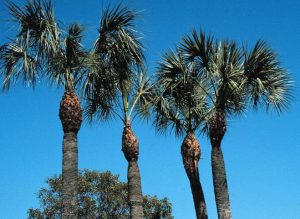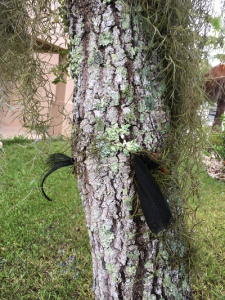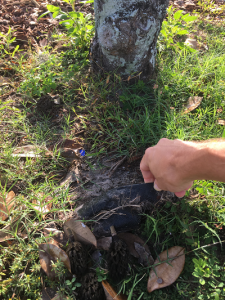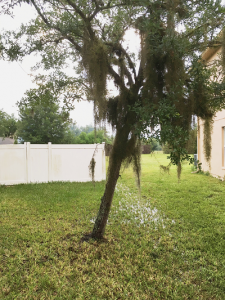Trees add value to our communities. But our recent windy weather serves as a good reminder that storm season is just around the corner. Given the large size attained by some trees, they can become hazardous to people and property when the wrong factors combine.
Here are a few important tips based on University of Florida research to help keep your trees healthy and reduce risk of storm damage.
Say “no” to ‘hurricane pruning’ of palms.

Image source – https://edis.ifas.ufl.edu/ep443
You might be bored and looking for projects while social distancing, but please put down the pole saw and step away from the palm…
University of Florida research has consistently found that palms are actually healthier & better able to handle storms when they have a FULL crown of leaves. Removing most of the leaves actually makes weak, narrow growth points that are MORE prone to breaking in a storm, not less…
In most cases, only fully brown, dead leaves should be removed from a palm.

Credit: T. K. Broschat, UF/IFAS – Source – http://edis.ifas.ufl.edu/pdffiles/ep/ep26600.pdf
While it may be tempting, DON’T cut off the yellowing leaves, even if they look ugly… Here’s why: Yellowing leaves are often a sign of a nutrient deficiency. When palms can’t get certain nutrients they need from the soil, they’re able to pull those nutrients from their oldest leaves in order to make new ones! As the palm “cannibalizes” those oldest leaves, they turn yellow. So pruning them off too early can actually remove the palm’s nutrient reservoir – make the nutrient deficiency WORSE… and the tree will simply be forced to pull nutrients from the next set of healthy, green leaves higher in the crown!
Side-note: If you’ve got a LOT of leaves suddenly wilting or changing color, your palm may actually have a disease issue. You can’t prune away a palm disease, but you can definitely spread it to other surrounding trees, so please give us a call or send us some photos – we’ll be happy to help narrow down what’s going on!
Final note on palms – To prevent the spread of deadly palm diseases, be sure that pruning equipment ALWAYS gets cleaned between every tree.
Too much mulch?

Mulch can be good for retaining moisture and preventing weeds, but DON’T pile it up around the trunk of your trees and shrubs. Burying the root flare of a tree can actually invite rot and decay of the roots and trunk. Over time, the health of the plant will decline, making them more hazardous during storms with high winds.
Ideally, you should be able to see the top of the root flare on most trees and shrubs. If it looks like you stuck a stick in the ground, you’ve probably got a plant that’s buried too deep.
The ties that bind…

Be sure that all strapping, ropes, wires, etc. aren’t cutting into the roots or trunk of your trees. When these supports are left on too long after planting, they can begin to girdle the growing tree.
As above, so below…
Make sure that the roots are also free of restrictions. Synthetic burlap and straps can restrict root growth and create hazardous situations as trees get larger.

Final thoughts –
- If your tree has dead limbs, hollow areas, missing bark, fungal growths, or has started leaning, NOW is the time to get it looked at – BEFORE we hit storm season.

- Remember, you’re dealing with safety and liability when it comes to trees, so ALWAYS hire a professional, certified arborist. A certified arborist can conduct a thorough hazard assessment and determine what is best for the tree, and for the people and property around it. You can use the International Society of Arboriculture’s website treesaregood.org to find a certified arborist near you.
So those are the 4 tree safety tips for today.
- Say no to hurricane pruning for palms.
- Don’t pile mulch all the way up around the base of your trees and shrubs.
- Be sure that strapping and ropes are loosened and/or removed before they begin to girdle your tree.
- ALWAYS hire a professional, certified arborist to care for your trees.
Further reading:
Benefits vs Costs of Urban Trees in Central Florida
Step Away From That Palm (nutrient deficiencies, diseases, & pruning.)
https://blogs.ifas.ufl.edu/pascoco/2019/05/07/step-away-from-that-palm/
Mulch 101 (The dos and don’ts of mulch)
https://blogs.ifas.ufl.edu/pascoco/2018/10/26/mulch-101/
About UF/IFAS Extension: UF/IFAS Extension serves as a source of non-biased, research-based information for the residents, businesses, and communities of Florida, providing educational materials and programs for adults and youth. We proudly “provide solutions for your life.”
(Not in Pasco County? Not a problem! Click here to find your local UF/IFAS Extension office!)
About the Author: As the Florida Friendly Landscaping (FFL) Program Coordinator in Pasco County, Frank works with the residents, homebuilders, and businesses of Pasco to help create attractive landscapes that DON’T require a lot of water, fertilizer, and pesticides. Through an innovative collaboration with Pasco County Utilities, the Pasco County FFL Program also provides on-site troubleshooting assistance to individuals and communities identified as high water users. His motto is – “Less guesswork, better landscapes.” Frank can be reached at fgaldo@ufl.edu
Thirsty for more FFL knowledge? Don’t forget to follow us on Facebook & Twitter!
Have an idea for a future post? Let me know at fgaldo@ufl.edu
by Frank Galdo
UF/IFAS Extension Is An Equal Opportunity Institution.
 1
1
